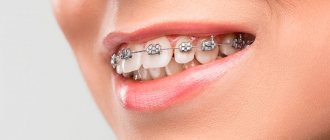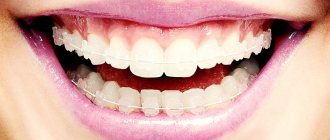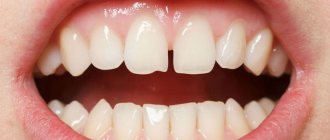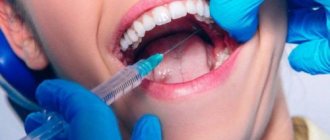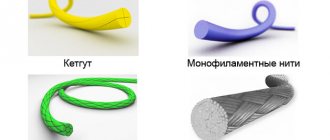“How long do you wear braces?” — this question is always asked by patients who come for a consultation at the orthodontic center for the first time. Their interest is understandable: when the duration of treatment with braces is known in advance, it is much easier to wait for the cherished date and easier to come to terms with the restrictions imposed. But even after a complete diagnosis, the doctor will not give an exact, but only an approximate time for correction. Everything will ultimately depend on self-discipline and the patient’s ability to accurately follow the dentist’s recommendations.
When will it be possible to remove braces from my teeth?
To change the position of the teeth in a row, you will have to wear braces for quite a long time - at least several months, but positive changes will appear much faster. By assessing the results of treatment with braces, the orthodontist will be able to indicate to you the expected completion date of the bite correction course.
The timing of treatment will depend to a certain extent on you: if you want to remove braces from your teeth as quickly as possible and at the same time acquire a beautiful smile with straight teeth, you must strictly follow all the orthodontist’s recommendations and not miss visits to the clinic to monitor the results of the correction.
Calculate the cost of treatment by taking a short test in 20 seconds!
Do not delay your treatment, because in this matter time plays against us.
Removing braces: how to remove the orthodontic structure
Where can braces be removed and how will the procedure take place? These questions concern many people undergoing orthodontic treatment or just preparing to wear braces. Many people think that it is painful or unpleasant, or mistakenly assume that they can remove braces themselves, at home. In fact, it is impossible to remove braces without visiting an orthodontist’s office. This is a simple and non-painful procedure, so there is no need to be afraid of it. To remove braces from your teeth, the doctor will not have to perform any complicated actions; the removal process will go through quite quickly. Lingual braces are removed within an hour, conventional vestibular braces are removed even faster - in 20-30 minutes.
How does the process work? We will describe to you the procedure for removing braces from your teeth in detail. So, to remove your braces, you will go to the orthodontist, and the doctor will do the following:
- Install a retractor in the oral cavity, which will protect the soft tissues of the mouth and mucous membranes during removal of braces;
- Remove the braces system. To remove the structure, the orthodontist will first remove the arches and ligatures, and then the braces themselves.
But simply removing the braces is not enough - after removing the orthodontic structure, be sure to remove any remaining adhesive from the dental surfaces, grind and polish the tooth enamel, and then treat it with a special remineralizing compound.
What is the price?
The pricing policy for brace removal is built taking into account the status of the clinic, the qualifications of the orthodontist, and regional characteristics.
On average, the procedure costs 6,000–10,000 rubles (about $150). In small cities the service is inexpensive - 3000-5000 rubles, in megacities the cost is 12000-15000 rubles.
When choosing a clinic, you should pay attention not only to the price level, but also to the professionalism of the doctors and reviews of patients who installed and removed braces.
Does it hurt to remove braces from your teeth?
One of the common questions from braces patients is: does it hurt to remove braces from your teeth? No, this procedure is painless and can be performed without the use of local anesthesia. Of course, some discomfort during removal of braces is not excluded, but it can be withstood without an anesthetic injection.
If you have a low pain threshold and high tooth sensitivity, warn your doctor about this. Then, before removing the braces, the doctor uses local anesthesia so that the removal procedure takes place without pain or discomfort.
Tips for a successful procedure
To ensure that the braces removal procedure is as comfortable and successful as possible, you should take into account the following recommendations from specialists:
- It is better to make an appointment to have your braces removed by the same specialist who installed them.
It is necessary to notify the dentist about the existing allergic disease (indicate which pathogen the body reacts to).
- In case of increased sensitivity, you should take a painkiller or inject anesthesia. Modern topical remedies are safe and do not cause an allergic reaction; they relieve pain instantly, relieving stress.
- to make an appointment to have your braces removed by the same specialist who installed them.
- If, after removing braces, problems with the enamel or gums are discovered , it is necessary to carry out restoration measures or even undergo a course of treatment as a matter of priority.
- While the doctor is working with a brace , the patient must limit his movements; otherwise, the instrument may slip off the surface of the teeth and touch the gums, thereby causing pain. The position of the body and head should also be maintained when grinding.
- An important point is the psycho-emotional background of the patient. Before the procedure, you should tune in to the positive, accept the fact as an intermediate one in long-term treatment, since after braces you will have to wear retainers for some time.
Can I remove braces myself?
One important thing you need to remember is that it is impossible to remove braces safely at home. In order to properly remove braces without damaging tooth enamel and soft tissues of the mouth, you need to have special knowledge, skills, and have dental instruments at your disposal. There are articles on the Internet that tell you how to remove braces at home, but do not follow the instructions given in them: this will not lead to anything good, you can damage your teeth and gums and provoke the development of an inflammatory process.
In addition, removing braces to complete orthodontic treatment is not enough. After the braces are removed, special structures are placed on the teeth - retainers, which secure the result of the bite correction and prevent the teeth from moving apart again. Retainers cannot be bought on the Internet or in a store, and what’s more, they cannot be installed correctly and securely on your own.
It is also impossible to remove the braces yourself because after removing the structure, the glue that was used to fix the plates remains on the teeth. To remove it, the surfaces of the teeth need to be sanded and polished. Remineralization of tooth enamel is also required to restore its structure after wearing braces for a long time.
Does it hurt?
It is not difficult to understand the fear of pain in patients who are about to part with their braces, but it should be said that during this procedure the doctor does not touch either the soft tissues of the oral cavity or the tooth enamel, except for grinding it after removing the structure. Accordingly, pain is almost completely eliminated, but the likelihood of this unpleasant phenomenon still exists and here’s why:
- During the process of removing braces, the patient becomes overly nervous, spins around in the chair and thereby increases the risk of injury;
- when separating the clasps from the tooth surface, discomfort may occur if the connection of the tooth with the glue is too tight;
- During grinding of enamel, pain may occur as a result of the grinding disc touching the gums, however, this is a consequence of the patient’s restlessness in the chair.
Is it possible to remove braces if the system breaks down?
Braces are durable structures that can withstand heavy loads well. But if the patient does not follow the doctor’s recommendations, the braces may come off. Even under these circumstances, you should not attempt to remove braces yourself! Such attempts may cause you to damage the entire system!
Therefore, there is no need to bother removing braces; your task in such a situation is to get an appointment with an orthodontist as quickly as possible, since the absence of even one element in the system disrupts the balance of the structure and significantly reduces the effectiveness of braces. If you cannot get to the orthodontist in the next day or two, visit the pharmacy, buy medical wax and use it to secure the bracket on the surface of the tooth from which it fell off.
Advantages and disadvantages of caps
The use of mouthguards is characterized by the following advantages:
- There are no difficulties in cleaning your teeth. The structure is removable, so a person can carry out standard hygiene measures without any restrictions.
- There are no dietary restrictions to follow. During the retention period, you are allowed to eat hard and sticky foods.
- Silicone elements do not break , which means there are no problems with their repair.
Among the disadvantages of these systems, orthodontists name:
- Lack of control over the patient's actions. A person may be irresponsible about the need to wear a structure and often take it off.
- Risk of forgetting to put on a mouthguard. This probability is especially high if it is used only at night.
What happens to my teeth after braces are removed?
One of the reasons why braces can only be removed in a dental clinic is the poor condition of the teeth. After removing braces, glue remains on the surface of the teeth; there may be noticeable cracks and white spots formed due to insufficient nutrition of the dental tissues while wearing braces.
It is important to understand that wearing braces negatively affects only aesthetics, but not the health of your teeth. Aesthetic defects will be easy to eliminate: to do this, it is enough to remove the braces, grind and polish the tooth enamel, and conduct a course of its remineralization. Usually these measures are quite enough to completely restore the aesthetics of the appearance of teeth.
But if you want to get the perfect Hollywood smile, then after removing braces, you can put veneers on your teeth, carry out the procedure for whitening tooth enamel, and resort to any other artistic restoration methods.
The result must be confirmed
The braces system is used to ensure that crooked teeth take the correct positions and form one even and beautiful row. They allow you to correct your bite and eliminate problems caused by occlusion.
The difficulty is that not only the teeth, but also the bone tissue in which they are fixed must get used to the new position. Otherwise, a few will soon take a more familiar position.
Under the pressure of the leveling apparatus, the units are displaced. Because of this, small empty areas form in the bone tissue. As soon as the orthodontist removes the retaining elements, you need to immediately fix all units of the row in the correct position. This will prevent their roots from returning to the vacated areas of the jawbone.
What procedures will be performed after braces are removed?
Removing braces does not mean ending the course of orthodontic treatment. First of all, the doctor will restore the aesthetic appearance of the teeth.
For this purpose, the following procedures are carried out:
1. Hygienic cleaning. This procedure allows you to remove residual adhesive, tartar and plaque from the surfaces of your teeth. Deposits actively accumulate under braces during the treatment period, and in order to keep teeth healthy, they must be removed.
2. Remineralization of tooth enamel after removal of braces. It is carried out by treating the surfaces of teeth with fluoride and calcium preparations, which saturate the weakened enamel with nutrients and restore its healthy structure.
We wrote above that after removing braces, you can do whitening to get a perfect smile. However, we advise you to remove your braces and wait about a month to whiten your teeth. During this time, the enamel and dental tissues will be sufficiently restored. If you whiten your teeth immediately after removing braces, there is a high risk of tooth hypersensitivity and even pain.
Let's take a look back
To get an idea of how braces are removed, you should remember how the system is secured in the patient's mouth. In this case, the key role is played by fixing preparations, which are very similar to the filling material familiar to many. First, the tooth must be cleaned of plaque, treated with a special liquid, and a bracket placed on a soft and pliable material. What happens next depends on the material used by the orthodontist: if it is photo-curable, it will set in a matter of seconds with the help of an ultraviolet lamp, but if a chemical substance is used, then the waiting time will be several minutes until it hardens.
Why do you need to remove braces and put retainers on your teeth?
Many patients are upset by the fact that it is not enough to remove the braces and complete the course of bite correction: after removing the braces, they will need to wear special structures on the teeth - retainers. Wearing retainers helps to consolidate the achieved positive result in correcting the bite, because if you remove the braces and do not put on the retainers - without the pressure that the brace system puts on the teeth, they will tend to return to their previous position.
Retainers will hold your teeth in the correct position and prevent them from moving. After your braces are removed, your orthodontist may suggest that you install removable or permanent retainers.
Fixed retainers
They are the thinnest wire that is glued to the inner surface of the teeth from the tongue side. Filling materials are used to fix the wire; it will be absolutely invisible to prying eyes and will not cause any discomfort when worn.
Removable retainers
When you come to the orthodontist to remove your braces, the specialist may offer you removable retainers.
These structures can be in the form of thin plates or silicone mouth guards and are worn over the teeth while you sleep. After removing braces, retention mouthguards are made according to an individual impression and their use requires a certain amount of discipline from the patient - if you don’t put the mouthguard on every day and forget about it, you can nullify all the positive results achieved from wearing braces. How long will you have to wear retainers after your braces are removed? Let's answer honestly - the retention period after removing braces is usually quite long; its duration can exceed the duration of the correction course by 2-3 times. And besides, some patients will have to wear retainers after removing braces for the rest of their lives to maintain a beautiful smile with straight teeth.
How long will you have to wear the structure?
Only a doctor can tell you how long to wear retainers For one person a year is enough, for another it will take several years. You can only estimate approximate times: to do this, multiply the time you spent with the bite correction system by two. The average is from 3 to 6 years, but everything is very individual.
There are exceptions in which there are no strict terms for wearing a retainer after braces . If the process of muscle training is very slow, you will have to walk with the plate all your life.
Will my teeth hurt after my braces are removed?
You need to prepare for the fact that you will experience physical discomfort for some time after your braces are removed. It occurs because the teeth, after removing braces, tend to return to their previous position, and retainers prevent this.
High tooth sensitivity may also occur, explained by the fact that while wearing braces, tooth enamel becomes thinner and weakens. Therefore, pain may occur when drinking hot/cold drinks and food.
The orthodontist must warn you about such side effects before removing braces. In addition, the specialist should advise you in detail on the proper care of your teeth and oral cavity after removing braces and installing retainers.
Causes of problems
Negative consequences of braces most often occur when medical recommendations are not followed, namely:
- poor oral hygiene;
- consumption of foods that are undesirable during treatment with braces;
- non-compliance with other medical recommendations (they are individual for each patient).
Problems when wearing braces can also arise due to weakened immunity and some individual characteristics of the body. It is important to consult a doctor in a timely manner to eliminate current disorders. Before installing the structure, the doctor weighs all the pros and cons of such treatment, taking into account the patient’s characteristics.
How to properly care for your teeth and oral cavity after removing braces?
After removing braces, weakened tooth enamel and tooth tissue need time to fully recover. This is why it is so important to ensure proper oral hygiene. It is imperative to undergo professional teeth cleaning and teeth remineralization procedures - they are performed in a clinic and may require several visits to a specialist’s office.
At home, after removing braces, you must regularly and thoroughly brush your teeth, use an irrigator or dental floss to remove plaque from the interdental spaces, and use balms and rinses to prevent gum inflammation. In all these procedures it is necessary to use gels and pastes, which the orthodontist will recommend to you. Usually, pastes with a high fluoride content are prescribed, as well as special remineralizing gels, which are used to treat the teeth after brushing.
Calculate the cost of treatment by taking a short test in 20 seconds!
Do not delay your treatment, because in this matter time plays against us.
Possible complications when wearing structures
As a rule, the orthodontist informs the patient about all the consequences that may occur due to the new system in the oral cavity before starting treatment. Many difficulties are normal for the adaptation period, however, some pathologies require specialist intervention.
The most common problems associated with wearing braces are:
- Sensation of a foreign body in the oral cavity.
A new device in your mouth will inevitably cause discomfort. However, over time, the owner of the system adapts to the new sensations and ceases to feel the braces. Typically, the adaptation period lasts 1-2 weeks after installation. - Pain in the periodontal area.
Unpleasant sensations in some areas of the gums are considered normal. Under pressure, the teeth gradually move into the correct position, which causes pain. This symptom does not appear in all patients and depends, first of all, on the severity of the defect. If the discomfort intensifies, dentists recommend taking a pain reliever. - Headache.
Surprisingly, when wearing orthopedic structures, patients often suffer from headaches. The pressure that the “braces” create on the teeth is transferred to the bones of the skull and acts on the nerve endings, which provokes painful sensations. - Rubbing of the mucous membrane, profuse salivation.
Braces are a foreign object in the oral cavity. The mucous membrane becomes irritated and increased salivation occurs. This phenomenon is also normal, especially if the patient wears bulky structures. In the first weeks, braces can injure the surface of the cheeks, lips, and tongue. - Inflammation of the gums.
A foreign body in the oral cavity can also cause inflammation of the soft tissues. As a rule, special gels, ointments and rinses help eliminate unpleasant symptoms.
To avoid inflammation, dentists recommend using special gels and ointments. An effective remedy that will help to successfully eliminate and prevent inflammation in the oral cavity is ASEPTA gum gel with propolis. The gel has anti-inflammatory, antimicrobial effects against gram-positive bacteria, as well as antipruritic and analgesic effects (reduces pain in affected tissues). The product also accelerates the process of regeneration and epithelization of wound surfaces and stimulates metabolic processes.
If the inflammation was caused by bacteria due to poor hygiene, the patient should definitely consult a dentist. The doctor will conduct a detailed examination of the oral cavity and, if necessary, prescribe adequate treatment.
Other common problems that accompany wearing braces include:
- Impaired diction.
Unfortunately, wearing braces at first inevitably provokes speech impairment. Diction is most strongly affected by lingual structures installed on the inside of the teeth. Over time, the speech defect goes away, and to speed up the adaptation process, patients are advised to read aloud. - Diet restrictions.
The process of correcting your bite inevitably affects your diet. Wearing braces requires avoiding nuts, seeds, soft drinks, and various sticky foods. Improper nutrition significantly reduces the life of the structure. - Unnatural smile.
. Many owners are embarrassed to smile widely, exposing their teeth. The smile turns out to be restrained; the lips cannot cover the increased volume of teeth. - Dry lips.
Those with braces inevitably suffer from excessive dry lips, so after installing the braces, be sure to stock up on moisturizing lipsticks and lip balms. - Caries and enamel damage.
Insufficient and illiterate oral hygiene provokes the accumulation of plaque on the teeth, which, when wearing braces, accelerates the development of caries. Before orthodontic treatment, it is recommended to have your teeth professionally cleaned and have dental check-ups every three months. The enamel structure can also be destroyed by an incorrectly installed system. - Destruction of the upper part of the roots of the teeth.
Due to excessive pressure aimed at moving the teeth, their upper part may be destroyed. Most often, owners of rounded and short teeth suffer from this problem. Such patients are recommended to undergo radiographic examination every six months to prevent the development of pathology. - Incorrect installation of the braces system
and, as a result, injury and inflammation of the gums, as well as various dental problems. - Difficulty in care.
Food debris often gets stuck between the enamel of the teeth and the arches of the braces, so after eating it is imperative to clean the mouth. If a toothbrush or a special orthodontic brush is not at hand, the patient should rinse his mouth thoroughly.
Most modern orthodontic structures are absolutely safe and hypoallergenic. However, if your body exhibits an unusual reaction after getting braces, it is important to see a doctor as soon as possible.
An allergy to braces usually manifests itself as a minor rash in or around the mouth. In rare cases, runny nose, dizziness, and shortness of breath may occur.
Is it possible to remove braces from teeth ahead of schedule?
It is possible to remove braces ahead of schedule only if the process of correcting the bite went faster than initially predicted. But such cases are very rare. More often, the need to remove braces ahead of schedule arises under the following circumstances:
- Conservative orthodontic treatment does not give a positive result. In this case, it is advisable to remove the braces and correct the bite with surgery;
- Braces will have to be removed if the system breaks down or if the patient has an allergic reaction to it.
Other reasons (including special occasions, significant events) are not considered valid for removing braces. Of course, if you insist, the doctor will remove the braces from your teeth and put them on after some time. But at the same time, you will have to install a new structure, and the treatment time may increase significantly. In addition, early removal of braces can have a negative impact on the functioning of the maxillofacial joint.
If you know that after some time a significant event is planned in your life, you lead a public lifestyle - it is best to initially make a choice in favor of aesthetic and invisible types of braces on the teeth - ceramic, sapphire, lingual brace systems. Then the braces will not have to be removed, and you will be able to complete the course of treatment without unnecessary expenses and visits to the clinic.
Retainers
This is also a system for correcting occlusion, which is used to consolidate the results of tooth movement and rotation carried out by braces.
Speaking about “consolidating results”, it is necessary to clarify what is meant by these words. The fact is that bone tissue grows very slowly. Much slower than the teeth moved and turned during the initial exposure to braces. Therefore, after removing braces from the mouth, the formation of the muscles and ligaments that hold the jaw in the desired new position has not yet been completed, and the connective tissue of the gums is not yet sufficiently strengthened after the previous movement of the tooth root in it under the constant pressure of the brace arches. A rough analogy for this is the wake on the water after the passage of a ship, which lasts for a very long time, sometimes for hours. And here, in the gum tissue, the trace of tooth movement lasts for years. And it stabilizes only simultaneously with a new growth of the jaw bone.
To prevent the tooth from returning to its original place, retainers are placed.
What will happen if they are not put in place - what, again, would guide a person when making such a decision? The teeth will begin to slowly, a millimeter at a time every two to three months, “drift” to their old places in the gums, and in a year or two you will get a crooked palisade in your mouth, exactly like before the unpleasant and lengthy procedure for installing braces .
Fixed retainers
The first, non-removable, are a strong flexible wire with “position memory”, which is set based on measurements of the curvature of the dentition after exposure to the braces system: it has already been removed, but the teeth are still frozen in a position of unstable equilibrium until a new growth of bone tissue at the roots.
A non-removable retainer with its plates is attached to the same glue that was used when installing the plates in the case of a braces system. Sometimes its installation is undertaken even before the braces are removed, fortunately, the retainer is installed on the back of the teeth, in a place inaccessible to view. But more often - after the removal of braces, traces of glue on the front surface of the teeth and measures to remineralize the enamel surface on the front side. The installation of a retainer is necessarily preceded by the procedure for removing tartar and generally thoroughly cleaning the tooth surface, without which it is impossible to make an accurate impression.
Among the advantages of a non-removable design:
- Invisibility to others
- Constant impact on the tooth around the clock
- Quick adaptation to the device
- No discomfort - does not affect diction.
Flaws:
- The need for constant medical monitoring of the state of the system.
- The possibility of the glue coming off the tooth – the location of the system on the back surface of the dentition initially implies a large load on it.
- Brushing your teeth is difficult and needs to be more thorough.
To relieve the latter inconvenience, the doctor should prescribe special toothpastes for cleaning teeth with retainers.
Removable retainers
Removable retainers, or trainers, are worn for up to 4 hours a day and must be left in the mouth overnight. They look like elastic, colorless and transparent silicone splints. They do not interfere with speech and breathing, and fix the tongue in the desired position.
Advantages of a removable retainer:
- After years of wearing braces, people get tired of having a foreign structure in their mouth. A removable one gives psychological rest and makes wearing it easier.
- Removable devices are very easy to clean with special brushes and paste.
Flaws:
- Due to thickening of the dentition, diction is impaired.
- Not an aesthetically pleasing appearance, noticeable to others.
- As a foreign body for oral receptors, they cause active secretion of saliva.
How long to wear retainers?
You need to know (and prepare for this in advance to avoid disappointment) that the period of wearing retainers is equal to or even longer than the period of wearing braces. That is, if braces to correct a malocclusion on the dentition were worn for 2 years, then you need to be prepared for the same 2 years (at least, and sometimes this period doubles!) These devices will remain on the teeth. In particularly difficult cases, retainers may have to be worn for the rest of your life. The doctor must also warn you about this.
Care
The most difficult thing to care for is permanent retainers, due to their location on the back edge of the tooth and the plate covering both the tooth enamel and the spaces between the teeth on the back side. In such conditions, tartar and other plaque forms more often. For quality care you need rinses and skills in using them, as well as some special toothbrushes of various shapes.
Once every six months you need to visit your doctor to have your teeth thoroughly cleaned in an office setting and using specialized equipment.
Production and installation price
You need two plates for installation - one each for the upper and lower jaws. The cost of each is within 4 thousand rubles.
Removing braces and simultaneously installing retainers costs from two to 8 thousand rubles. In private clinics, however, they may offer you discounts and bonuses in the form of free services for certain types of manipulations for the entire period of observation of the teeth being corrected.
It must be remembered that, despite the variety of forms of treatment and fixation of teeth after using braces, only retainers provide reliable correction results.
Used Books:
- https://en.wikipedia.org/wiki/Dental_braces
- Proffitt U.R., Modern orthodontics (3rd edition), MEDpress-inform, 2015, 560 p.
- Artun J, Smale I, Behbehani F, Doppel D, Van't Hof M, Kuijpers-Jagtman AM (2005). “Apical root resorption six and 12 months after initiation of fixed orthodontic appliance therapy”


